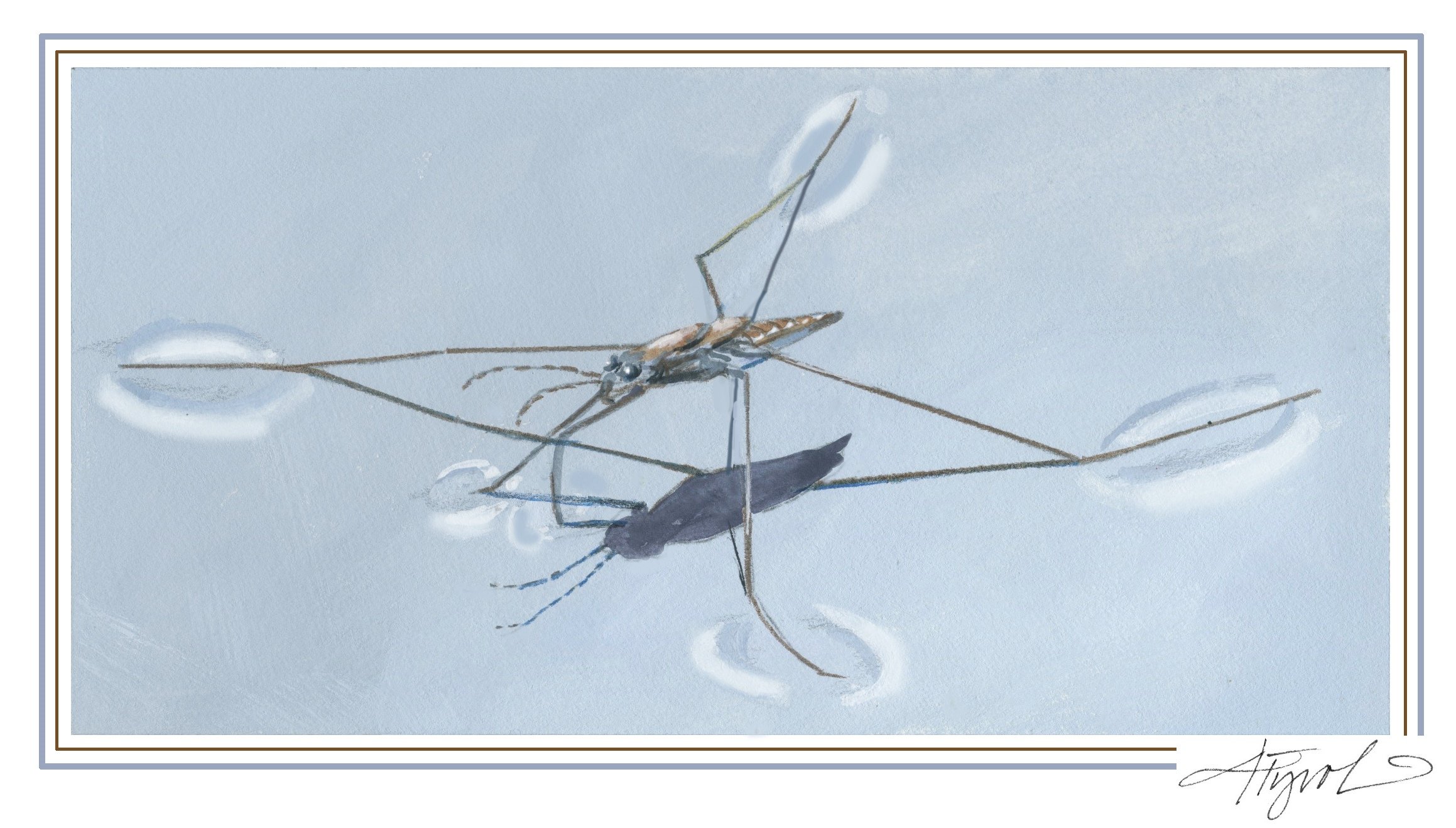How water striders manage raindrops
August 17, 2024 | By Rachel Sargent Mirus | The Outside StoryIllustration by Adelaide Murphy Tyrol
Water striders are a common sight on ponds, vernal pools, and puddles. During clear summer days, these insects seem to walk on water – a feat they accomplish through a combination of long legs that distribute their weight across the water’s surface and micro hairs that make these invertebrates extremely water-repellent. But what happens to these water walkers when it rains?
It seems logical that a shower of water would capsize tiny floating insects. During heavy rain, something the size of a water strider can be struck by a drop on average every seven seconds. And each of those drops can have five times more mass than an adult strider. Daren Watson, assistant professor of mechanical engineering at Florida Polytechnic University, set out to determine how these bugs stay afloat.
Watson set up a rainfall simulator in the lab. A nozzle at ceiling height dropped water into an artificial pool containing many water striders. Watson’s lab-made “rain” fell at the slow end of the range of velocities for natural rain. He recorded video of the striders as they were struck by the drops, later analyzing their reactions in slow motion.
When a drop of rain strikes the water's surface, it forms a crater that collapses, then rebounds into a jet, which drops back into a second crater. Finally, the water ripples back into a rest state. This entire series of very fast events is one “splash.” A raindrop splash happens much too quickly for a water strider to anticipate and move out of the way.
“A direct, initial splash always pushes them underwater, mainly because of how light [the bugs] are,” Watson said. During his experiments in the lab, water striders were submerged by the initial strike and first crater formation, then carried upwards when the jet formed. In one case, however, a strider leaped from the top of the jet, landing well away from the splash zone and escaping further wetting.
Most striders in the lab fell back into the second crater as the jet collapsed. If a strider landed near the bottom of that crater, it was again dragged under the water's surface. Water striders that were resubmerged were always able to propel themselves back to the surface, thanks to their adaptations for buoyancy, and their ability to swim underwater.
The extremely water-repellent micro hairs covering their bodies help water striders resurface. These hairs trap a bubble of air, called a plastron, around a strider’s body to create extra buoyancy. Water striders additionally use their plastron to breathe while submerged, like a scuba diver’s air tank. Water striders can also swim underwater, which they do by rotating their long middle legs forward and then paddling them back.
During Watson’s lab experiments, he observed that repeated drop impacts are likely to reduce a strider’s plastron, indicating that during heavy rain, the insects may eventually become waterlogged, which could leave them trapped below the water surface. Nevertheless, a strider without a plastron still has options for resurfacing. Submerged striders in the lab used their legs to grab and climb onto floating acrylic squares in their habitat. In the outside world, water plants and floating debris may be important to their survival during heavy rain.
Watson also tested how water striders survive being compressed, as happens when they are struck by falling water drops. He found that striders can survive compression forces more than double the force generated by drops falling at the fastest possible speed of rain.
Watson is looking forward to researching additional questions related to water striders and physics. For example, he and his team hypothesize that striders can be a model for how other lightweight, hydrophobic items, such as microplastics, behave in aquatic environments. “I totally enjoyed this project,” he said. “We stepped outside of the box – what mechanical engineers tend to do. This was a fusion of biology, fluid mechanics, and physics.” It was also an example of how asking a simple question about a familiar insect can lead to new insights about nature.
Rachel Sargent Mirus is a teaching artist and writer. The Outside Story is assigned and edited by Northern Woodlands magazine and sponsored by the Wellborn Ecology Fund of New Hampshire Charitable Foundation.

